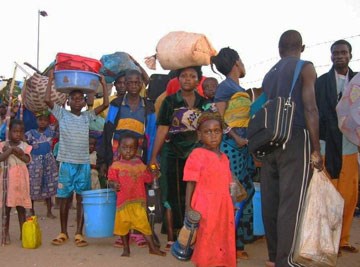Quota for resettlement refugees for 2009
Historical archive
Published under: Stoltenberg's 2nd Government
Publisher: Ministry of Foreign Affairs
News story | Date: 02/02/2009 | Last updated: 05/02/2009
The quota for resettlement refugees for 2009 has now been set. In line with the decision in the Storting (Norwegian parliament), Norway will take in 1200 refugees who will be selected by the Norwegian immigration authorities in cooperation with UNHCR.
The quota for resettlement refugees for 2009 has now been set. In line with the decision in the Storting (Norwegian parliament), Norway will take in 1200 refugees who will be selected by the Norwegian immigration authorities in cooperation with UNHCR. The quota this year will primarily be filled by refugees from Eritrea, Afghanistan, Burma, Bhutan and Iraq. Norway aims to fill 55% of the quota with women.
 Each year, Norway opens its doors to a certain number of resettlement refugees. These are refugees who have no possibility of returning to their home country or of being integrated into the country where they first sought refuge. The Storting decides the number of quota refugees that Norway will take in on the basis of the Government’s annual budget proposal. The reason this decision is based on the budget proposal is the costs connected with the reception and integration of refugees. The cost over a five-year period for a single resettlement refugee is estimated at NOK 500 000, in the form of funding to the local authority responsible.
Each year, Norway opens its doors to a certain number of resettlement refugees. These are refugees who have no possibility of returning to their home country or of being integrated into the country where they first sought refuge. The Storting decides the number of quota refugees that Norway will take in on the basis of the Government’s annual budget proposal. The reason this decision is based on the budget proposal is the costs connected with the reception and integration of refugees. The cost over a five-year period for a single resettlement refugee is estimated at NOK 500 000, in the form of funding to the local authority responsible.
The Ministry of Labour and Social Inclusion decides on which groups of refugees the Government should offer to resettle in Norway. Input from the United Nations High Commission for Refugees (UNHCR), the Norwegian Ministry of Foreign Affairs and Norwegian NGOs is also taken into account. Many considerations are taken, including the needs of the various groups of refugees, the extent to which other countries have offered to resettle them, their integration potential (as a group, not individually) and the extent to which resettlement may encourage the authorities in other countries (the country of origin or the country in which they first sought refuge) to find a long-term solution for the group as a whole.
Once the composition of the quota has been decided, UNHCR puts forward relevant cases. These are persons whom UNHCR has already assessed as having refugee status and a need for resettlement in a third country. In Norway, it is the Directorate of Immigration (UDI) that takes the decision on the individual cases that are put forward.
In addition to the quotas for groups of specific ethnic origin or nationality, there is also an open quota, an emergency quota and a quota for refugees who need medical treatment.
The quotas for 2009 are as follows:
Iraqis and Palestinians in the Middle East: 200
Vulnerable Afghan women in Pakistan or Iran: 200
Eritreans in Sudan or Ethiopia: 200
Bhutanese in Nepal: 150
Burmese with connections to Norway: 100
Open places: 175
Medical cases: 20
Emergency cases: 75
Convertible places: 80
Total: 1200